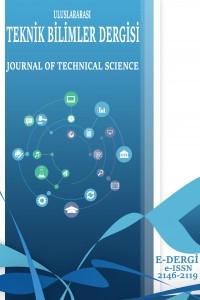Eğilme Etkisi Altındaki Kutu Kesitli Kiriş-Kolon Birleşiminde Modelleme Tekniklerinin Birleşim Davranışı Üzerine Etkisi
Sismik yüke maruz kalan yapılar, sahip oldukları geometri, yapı elemanlarının kesit özellikleri ve malzeme sınıfına göre bir yapısal davranış ortaya koyarlar. Ortaya konan bu yapısal davranış, depremin talebine karşı yapının oluşturduğu bir reaksiyon durumudur. Deprem bir kinetik enerji hali ise, yapı mevcut hali bir potansiyel enerji olarak algılanabilir ve gelen enerjiyi dengelemelidir. Yapının bütünde ya da bütünü oluşturan elemanlarda bu dengeleme gelen enerjinin boyutuna göre elastik veya plastik sınır dahilinde gerçekleşir. Plastik sınır dahilinde gerçekleşen denge durumu yapı elemanlarında kalıcı deformasyonlara sebep olmakta ve parçadan bütüne gittiğimizde yapı kapasitesini etkilemektedir. Depreme dayanıklı yapı tasarımında etkili olmanın ölçütlerinden biriside bu deformasyonlara ait algoritmanın doğru bir şekilde belirlenmesidir. Ancak günümüzde kullanılan statik analiz programlarının, yada kullanıcıların eksikliklerine bağlı olarak yapısal model tam anlamıyla sayısallaştırılamamaktadır. Bu sebeple tasarıma bağlı davranış bozuklukları öngörülememekte ve yapı daha tasarım aşamasında kusurlu doğmaktadır. Bu çalışmada, deneysel analizi tamamlanan Dairesel kesitli kolon-dikdörtgen kesitli kirişin alın levhalı kaynaklı moment aktaran birleşimi Ansys sonlu elemanlar programı kullanılarak sayısal olarak modellenmiştir. Deneysel analize göre doğrulanan sayısal model sabit yükleme düzeneği üzerinde farklı yaklaşımlar için analizler yapılmıştır. Bu kapsamda elde edilen sonuçlar karşılaştırılarak modelleme tekniğinin düğüm noktası davranışı üzerine etkisi gösterilmeye çalışılmıştır.
Anahtar Kelimeler:
Dairesel Kesitli Kutu Profiller, CHS, Dikdörtgen Kesitli Kutu Profiller, RHS, Alın Levhalı Kaynaklı Moment Aktaran Birleşimler, Moment Aktaran Çelik Çerçeve Sistemler, Süneklilik Detayı
Modeling Tecniques of Under Bending Box Section Beam-Column Joints Effects on Connection Behaviour
Structures subjected to seismic loads, they have geometry, section properties of building components and materials according to the class they revealed a structural behavior. This structural behavior of structures is a demand to earthquakes a reaction. If the earthquake is a kinetic energy state, the potential energy can be perceived as a structure in its current form and must balance the energy. In cases where reciprocal compensation of these two energy difference by the damping of the structure are desired. Make this condition is referred to as ductility and energy dissipation capability. In this study, it is aimed to investigate ductility details for the connection of end plate welded moment resisting connections of the "circular hollow section column - rectangle hollow section beam" columns. At the end plate welded moment resisting connections, the effect of the profile sizes and material features on the buckling types, cycling loads will be examined experimentally and numerable. In this context, comparing the results obtained from modeling of techniques have been tried to show the effect on joint behavior
Keywords:
Circular Hollow Section Profiles, CHS, Rectangular Hollow Section Profiles, End Plate Welded Moment Resisting Connections, Moment Resisting Steel Frames, Cycling Static Loads, Ductility Details,
___
- Davies, G., Crockett, P., 1996. The Strength of Welded T-DT Joints In Rectangular and Circular Hollow Section Under Variable Axial Loads. Elsevier Science Ltd. 1996.
- Design Guide 3, 2009. For Rectangular Hollow Predominantly
- International Pour Le Développement Et L’étude De La Construction Tubulaire.
- Garlock, M.M., Ricles, J.M., Sause, R., 2005. Experimental Studies Of Full-Scale Post Tensioned Steel Connections. Journal Of Structural Engineering, March 2005, 438- 448.
- Koning, C.H.M. de, Wardenier, J., 1984. The Static Strength Of Welded Joints Between Structural Hollow Sections Or Between Structural Hollow Sections And H-Sections. Delft University Of Technology, Delft, Part 2: Joints Between Rectangular Hollow Sections, Stevin Report 6-84-19.
- Korol, R.M., El-Zanaty, M., Brady, F.J., 1977. Unequal Width Connections Of Square Hollow Sections In Vierendeel Trusses. Canadian Journal of Civil
- Engineering, 4, 190-201.
- Mang, F., Bucak, Ö., Wolfmuller, F., 1983. The Development Of Recommendations For The Design Of Welded Joints Between Steel Structural Hollow Sections (T- And X-Type Joints). University of Karlsruhe,
- Germany, Final Report on ECSC Agreement 7210 SA/l 09 and CIDECT Program 5AD.
- Mashiri, F.R., Zhao, X. L., 2009. Square Hollow Section (SHS) T-Joints With Concrete-Filled Chords Subjected To In- Plane Fatigue Loading In The Brace.
- Thin-Walled Structures, 48, 150–158.
- Wardenier, J., 1982. Hollow Section Joints. Delft University Press, Delft.
- Wardenier, J., Vegte, G.J. van der, Liu, D.K., 2007a. Chord Stress Function
- For Rectangular Hollow Section X And T Joints. Proceedings 17th International Offshore And Polar Engineering Conference, Lisbon, Portugal, IV, 3363- 3370.
- Zhao, X. L., 2000. Deformation Limit And Ultimate Strength Of Welded T-JointsIn Cold-Formed RHS Sections. Journal of Constructional Steel Research, 53, 149–165.
- Yayın Aralığı: Yılda 2 Sayı
- Başlangıç: 2011
- Yayıncı: Isparta Uygulamalı Bilimler Üniversitesi
